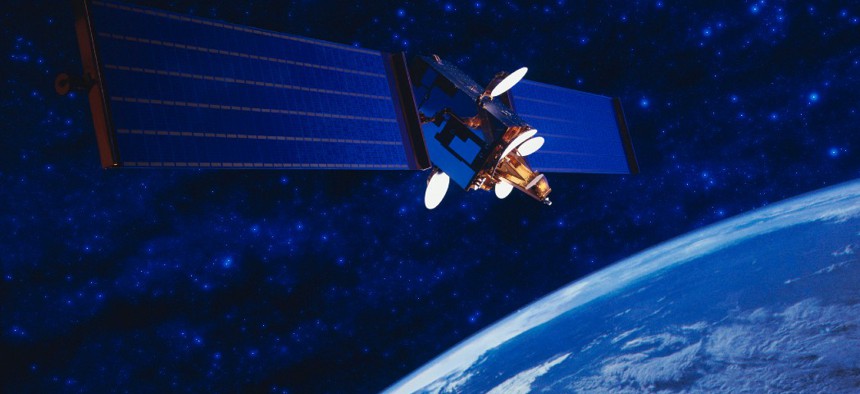SES moves to double its US government footing through acquisition

Max Dannenbaum/Getty Images
The global satellite company is purchasing a subsidiary of Leonardo DRS that integrates those networks into a managed offering for government users.
Commercial satellite network operator SES is moving to acquire a business unit of defense technology company Leonardo DRS in a transaction that doubles the former’s sales to U.S. government agencies.
SES said Tuesday it agreed to pay $450 million for the DRS Global Enterprise Solutions subsidiary, which integrates satellite communications networks from multiple providers into a managed service offering for the Defense Department and other federal users.
All parties expect to close the transaction in the second half of this year, upon which the DRS GES business will become a part of SES Government Solutions: a subsidiary of SES focused on the federal market.
In an accompanying investor presentation, SES said the DRS GES business generates around $250 million in annual revenue. Its purchase would move the SES Government Solutions business’ top line to nearly $500 million in annual sales.
But we also see how the notion of scale is not just in the financials. It also extends to what the customers are asking for, as well as in the product offering SES provides through its fleet of 70 satellites.
During a conference call with investors Tuesday, SES CEO Steve Collar said all government agencies are prioritizing space and multiple-orbit satellite solutions for defense and civilian usage.
“We're seeing this translate into strong growth in demand for satellite-enabled connectivity to support a wide range of these applications, including intelligent surveillance and reconnaissance, [communications] on the move, comms on the pause and morale, welfare and recreation,” Collar told analysts.
SES sees the potential in providing the DRS GES business access to the former’s satellite networks, including the next-generation O3b mPOWER network that should go live toward the end of this year.
The idea there is to provide customers networks across multiple orbits and terrestrial solutions, which combine SES’ medium-Earth orbit offering with its own fleet in geosynchronous orbit.
Since its inception two decades ago, the DRS GES business has focused on putting together multiband offerings for defense and intelligence customers including the Army and Special Operations Command. DRS GES also wraps enterprise IT and cybersecurity services into the overall offering.
While Collar characterized the work with SOCOM as DRS GES’ “most successful relationship,” he also cited the Federal Emergency Management Agency as a civilian client to illustrate the “diversified set of end-users.”
The competitive and partnership landscape that DRS GES is in also must be taken into account.
John-Paul Hemingway, SES’ chief strategy and product officer, said his company provides about 10% of DRS GES’ network capacity today. That gives SES “room to shift that balance and move us higher up the order,” Hemingway added.
“What this move does is it gives [DRS GES] privileged access to the very best of our assets on a global basis. So that will be good for their customers,” Hemingway said. “They will get the best of the best of SES and continue to get third-party capacity as they would need to.”
The acquisition is subject to regulatory approvals including the antitrust review process and evaluation by the Committee on Foreign Investment in the U.S.
CFIUS also has jurisdiction over the matter given the headquarters of both parent companies are outside of the U.S., with SES in Luxembourg and DRS’ owner Leonardo in Italy.
For Leonardo, this divestiture comes one year after the conglomerate postponed an initial public offering that would have made nearly one-fifth of the equity in the DRS subsidiary available to investors.
Leonardo DRS has shifted its portfolio focus since that IPO withdrawal and believes the sale of its satellite communications business will both free up the aperture and gain more financial resources to consider larger acquisitions.
"As we enter a new and exciting phase at Leonardo DRS, we remain focused on shaping the future of the battlefield by developing advanced technologies to address the complex needs of the Department of Defense," Leonardo DRS CEO William Lynn said in a release.
"These investments will strengthen our core capabilities and deliver market-disruptive technologies for our customer needs today, and well into the future.”
Leonardo DRS’ most recent acquisition took place over the summer of last year when it purchased Ascendant Engineering Solutions, a maker of gimbal technology that stabilizes and enables movements of sensors and cameras installed on platforms.
Regarding the transaction between SES and Leonardo: the former was advised by Gibson Dunn, Hogan Lovells and SatCom Law.
Leonardo and the DRS subsidiary were assisted by Morgan Stanley as financial adviser and by Curtis, Mallet-Prevost, Colt & Mosle as legal adviser.
NEXT STORY: How X-Bow mixes the old and new in rocket tech
